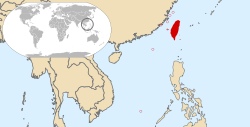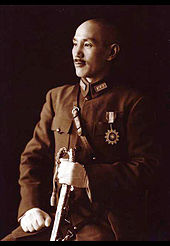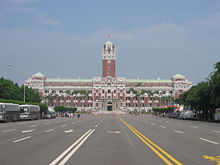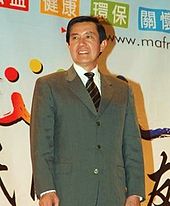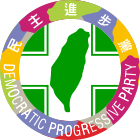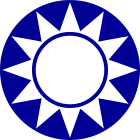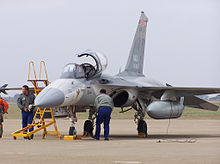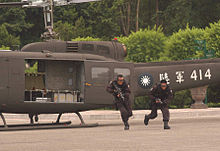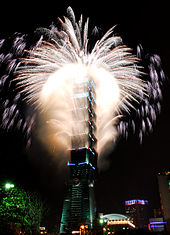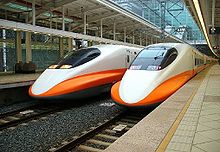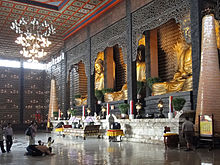
Taiwan
Background to the schools Wikipedia
SOS Children, an education charity, organised this selection. SOS Children works in 45 African countries; can you help a child in Africa?
|
|||||||||||||||||||||||||||||||||||||||||||||||||||||||||||||||||||||||||||||||||||||||||||||||||||||||||||||||||||||||||||||||||||||||||||||||||||||||||||||||||||||||||||||||||||||||||||||||||||||||||||||||||||||||||||||||||||
Taiwan ( / ˈ t aɪ ˈ w ɑː n / TY-WAHN Chinese: 臺 灣 or 台 灣; pinyin: Táiwān; see below), officially the Republic of China (ROC; Chinese: 中 華 民 國; pinyin: Zhōnghuá Mínguó), is a state in East Asia. Originally based in mainland China, the Republic of China now governs the island of Taiwan (formerly known as "Formosa"), which makes up over 99% of its territory, as well as Penghu, Kinmen, Matsu, and other minor islands. Neighboring states include the People's Republic of China to the west, Japan to the east and northeast, and the Philippines to the south. Taipei is the political capital as well as economic and cultural centre in Taiwan. New Taipei is the most populous city.
The island of Taiwan was mainly inhabited by Taiwanese aborigines until the Dutch period in the 17th century when ethnic Chinese began immigrating to the island. The Qing Dynasty of China later conquered Taiwan in 1683. By the time Taiwan was ceded to Japan in 1895, the majority of Taiwan's inhabitants were Han Chinese either by ancestry or by assimilation. The Republic of China (ROC) was established in China in 1912. At the end of World War II in 1945, Japan surrendered Taiwan to ROC military forces on behalf of the Allies. Following the Chinese civil war, the Communist Party of China took full control of mainland China and founded the People's Republic of China (PRC) in 1949. The ROC relocated its government to Taiwan, and its jurisdiction became limited to Taiwan and its surrounding islands. In 1971, the PRC assumed China's seat at the United Nations, which the ROC originally occupied. International recognition of the ROC has gradually eroded as most countries switched recognition to the PRC. Only 22 UN member states and the Holy See currently maintain formal diplomatic relations with the ROC, though it has informal ties with most other states via its representative offices.
Constitutionally, the ROC government has claimed sovereignty over all of "China", in a definition that includes mainland China and Outer Mongolia, as well as Taiwan, but has not made retaking mainland China a political goal since 1992. However, the government's stance on defining its political position largely depends on which political coalition is in charge. Meanwhile, the PRC also asserts itself to be the sole legal representation of China and claims Taiwan to be under its sovereignty, denying the status and existence of ROC as a sovereign state. The PRC has threatened the use of military force as a response to any formal declaration of Taiwanese independence, or if it deems peaceful reunification no longer possible. Relations between Taiwan and China as well as issues of national identity within the country are important factors in Taiwanese politics and a cause of social and political division among political parties and their respective supporters.
During the latter half of the 20th century, Taiwan experienced rapid economic growth and industrialization and is now an advanced industrial economy. In the 1980s and early 1990s, Taiwan evolved into a multi-party democracy with universal suffrage. Taiwan is one of the Four Asian Tigers and a member of the WTO and APEC. The 19th-largest economy in the world, its advanced technology industry plays a key role in the global economy. Taiwan is ranked highly in terms of freedom of the press, health care, public education, economic freedom, and human development.
Names
There are various names for the island of Taiwan in use today, derived from explorers or rulers by each particular period. The former name Formosa (福爾摩沙) dates from 1544, when Portuguese sailors sighted the main island of Taiwan and named it Ilha Formosa, which means "Beautiful Island". In the early 17th century, the Dutch East India Company established a commercial post at Fort Zeelandia (modern Anping, Tainan) on a coastal islet called "Tayouan" in the local Siraya language; the name was later extended to the whole island as "Taiwan". Historically, "Taiwan" has also been written as 大灣, 臺員, 大員, 臺圓, 大圓 and 臺窩灣.
The official name of the state is the "Republic of China"; it has also been known under various names throughout its existence. Shortly after the ROC's establishment in 1912, while it was still located on the Asian mainland, the government used the abbreviation "China" ("Zhongguó") to refer to itself. During the 1950s and 1960s, it was common to refer to it as "Nationalist China" (or "Free China") to differentiate it from "Communist China" (or "Red China"). It was present at the UN under the name "China" until 1971, when it lost its seat to the People's Republic of China. Since then, the name "China" has been commonly used internationally to refer only to the People's Republic of China. Over subsequent decades, the Republic of China has become commonly known as "Taiwan", after the island that composes most of its territory. The Republic of China participates in most international forums and organizations under the name " Chinese Taipei" due to diplomatic pressure from the PRC. For instance, it is the name under which it has competed at the Olympic Games since 1979, and its name as an observer at the World Health Organization.
History
Aboriginal Taiwan
Taiwan was joined to the Asian mainland in the Late Pleistocene, until sea levels rose about 10,000 years ago. Fragmentary human remains have been found on the island, dated 20,000 to 30,000 years ago, as well as later artifacts of a Paleolithic culture.
More than 4,000 years ago farmers from mainland China, believed to be the ancestors of current Taiwanese aborigines, settled on Taiwan. Their languages belong to the Austronesian language family, which also includes the Malayo-Polynesian languages spanning a huge area from Madagascar to Easter Island. The aboriginal languages on Taiwan show much greater diversity than the rest of Austronesian put together, leading linguists to propose Taiwan as the Urheimat of the family, from which seafaring peoples dispersed across southeast Asia and the Pacific and Indian Oceans.
Han Chinese began settling in the Penghu islands in the 13th century, but Taiwan's hostile tribes and its lack of trade resources valued in that era rendered it unattractive to all but "occasional adventurers or fishermen engaging in barter" until the 16th century.
Opening in the 17th century
The Dutch East India Company attempted to establish a trading outpost on the Penghu Islands (Pescadores) in 1622, but were driven off by the Ming authorities. In 1624, the Company established a stronghold called Fort Zeelandia on an coastal islet of Tayouan, which is now part of the main island at Anping, Tainan. David Wright, a Scottish agent of the Company who lived on the island in the 1650s, described the lowland areas of the island as being divided among 11 chiefdoms ranging in size from two settlements to 72. Some of these fell under Dutch control while others remained independent. The Company began to import laborers from Fujian and Penghu (Pescadores), many of whom settled.
In 1626, the Spanish landed on and occupied northern Taiwan, at the ports of Keelung and Tamsui, as a base to extend their trading. This colonial period lasted sixteen years until 1642, when the last Spanish fortress fell to Dutch forces.
Following the fall of the Ming Dynasty, Koxinga (Zheng Chenggong), a self-styled Ming loyalist, arrived on the island and captured Fort Zeelandia in 1662, expelling the Dutch government and military from the island. Koxinga established the Kingdom of Tungning (1662–1683), with his capital at Tainan. He and his heirs, Zheng Jing, who ruled from 1662 to 1682, and Zheng Keshuang, who ruled less than a year, continued to launch raids on the south-east coast of mainland China well into the Qing Dynasty.
Qing rule
In 1683, following the defeat of Koxinga's grandson by an armada led by Admiral Shi Lang of southern Fujian, the Qing formally annexed Taiwan, placing it under the jurisdiction of Fujian province. The Qing imperial government tried to reduce piracy and vagrancy in the area, issuing a series of edicts to manage immigration and respect aboriginal land rights. Immigrants mostly from southern Fujian continued to enter Taiwan. The border between taxpaying lands and "savage" lands shifted eastward, with some aborigines becoming Sinicized while others retreated into the mountains. During this time, there were a number of conflicts between Chinese from different regions of southern Fujian, and between southern Fujian Chinese and aborigines.
Northern Taiwan and the Penghu Islands were the scene of subsidiary campaigns in the Sino-French War (August 1884 to April 1885). The French occupied Keelung on 1 October 1884, but were repulsed from Tamsui a few days later. The French won some tactical victories but were unable to exploit them and the Keelung Campaign ended in stalemate. The Pescadores Campaign, beginning on 31 March 1885, was a French victory, but had no long-term consequences. The French evacuated both Keelung and the Penghu archipelago after the end of the war.
In 1885, the Qing redesignated Taiwan Prefecture of Fujian as Taiwan Province, the twentieth in the empire, with its capital at Taipei. This was accompanied by a modernization drive that included building Taiwan's first railroad and starting a postal service.
Japanese rule
The Qing Dynasty was defeated in the First Sino-Japanese War (1894–1895) and Taiwan and Penghu were ceded in full sovereignty to the Empire of Japan. Inhabitants wishing to remain Qing subjects were given a two-year grace period to sell their property and move to mainland China. Very few Taiwanese saw this as feasible. On 25 May 1895, a group of pro-Qing high officials proclaimed the Republic of Formosa to resist impending Japanese rule. Japanese forces entered the capital at Tainan and quelled this resistance on 21 October 1895.
Japanese rule was instrumental in the industrialization of the island, extending the railroads and other transportation networks, building an extensive sanitation system and establishing a formal education system. Japanese rule ended the practice of headhunting. During this period, both rice and sugarcane production greatly increased. By 1939, Taiwan was the seventh greatest sugar producer in the world. Still, the Taiwanese and aborigines were classified as second- and third-class citizens. After suppressing Chinese guerrillas in the first decade of their rule, Japanese authorities engaged in a series of bloody campaigns against the mountain aboriginals, culminating in the Wushe Incident of 1930.
Around 1935, the Japanese began an island-wide assimilation project to bind the island more firmly to the Japanese Empire and people were taught to see themselves as Japanese. During World War II, tens of thousands of Taiwanese served in the Japanese military. For example, former ROC President Lee Teng-hui's elder brother served in the Japanese navy and died while on duty in the Philippines in February 1945. The Imperial Japanese Navy operated heavily out of Taiwanese ports. The " South Strike Group" was based at the Taihoku Imperial University in Taipei. Many of the Japanese forces participating in the Aerial Battle of Taiwan-Okinawa were based in Taiwan. Important Japanese military bases and industrial centers throughout Taiwan, like Kaohsiung, were targets of heavy American bombing.
In 1938 there were 309,000 Japanese settlers in Taiwan. After World War II, most of the Japanese were repatriated to Japan.
After World War II
On 25 October 1945, the US Navy ferried ROC troops to Taiwan in order to accept the formal surrender of Japanese military forces in Taipei (then called "Taihoku"). General Rikichi Andō, governor-general of Taiwan and commander-in-chief of all Japanese forces on the island, signed the instrument of surrender and handed it over to General Chen Yi of the ROC military to complete the official turnover. Chen Yi proclaimed that day to be " Retrocession Day of Taiwan", but the Allies considered Taiwan and the Penghu Islands to be under military occupation but still under Japanese sovereignty until 1952.
The ROC administration of Taiwan under Chen Yi was strained by increasing tensions between Taiwan born people and newly arrived mainlanders, which were compounded by economic woes, such as hyperinflation. Furthermore, cultural and linguistic conflicts between the two groups quickly led to the loss of popular support for the new government. The shooting of a civilian on 28 February 1947 triggered island-wide unrest, which was suppressed with military force in what is now called the 228 Incident. Mainstream estimates of the number killed range from 18,000 to 30,000, mainly Taiwanese elites.
Chinese Nationalist one-party rule
After the end of World War II, the Chinese Civil War resumed between the Chinese Nationalists (Kuomintang), led by Chiang Kai-shek, and the Chinese Communist Party, led by Mao Zedong. By 1949, a series of Chinese Communist offensives led to the defeat of the Nationalist army, and the Communists founded the People's Republic of China on 1 October.
In December 1949, Chiang evacuated his government to Taiwan and made Taipei the temporary capital of the ROC (also called the "wartime capital" by Chiang Kai-shek). Some 2 million people, consisting mainly of soldiers, members of the ruling Kuomintang and the intellectual and business elites, were evacuated from mainland China to Taiwan at that time, adding to the earlier population of approximately six million. In addition, the ROC government took to Taipei many national treasures including China's gold reserves and foreign currency reserves.
From this point onwards, the Kuomintang was reduced to control of Taiwan, Kinmen, Matsu Islands, and two major islands of Dongsha Islands and Nansha Islands. The Kuomintang continued to claim sovereignty over all "China", which it defined to include mainland China, Taiwan, Outer Mongolia and other areas. On mainland China, the victorious Communists claimed they ruled the sole and only China (which they claimed included Taiwan) and that the Republic of China no longer existed.
Martial law, declared on Taiwan in May 1949, continued to be in effect after the central government relocated to Taiwan. It was not repealed until 1987, and was used as a way to suppress the political opposition in the intervening years. During the White Terror, as the period is known, 140,000 people were imprisoned or executed for being perceived as anti-KMT or pro-Communist. Many citizens were arrested, tortured, imprisoned and executed for their real or perceived opposition to the Kuomintang. Since these people were mainly from the intellectual and social elite, an entire generation of political and social leaders was decimated. It was not until 2008 that a public apology was made for those actions. No form of restitution or compensation has been made as of 2010.
Initially, the United States abandoned the KMT and expected that Taiwan would fall to the Communists. However, in 1950 the conflict between North Korea and South Korea, which had been ongoing since the Japanese withdrawal in 1945, escalated into full-blown war, and in the context of the Cold War, US President Harry S. Truman intervened again and dispatched the 7th Fleet into the Taiwan Straits to prevent hostilities between Taiwan and mainland China. In the Treaty of San Francisco and the Treaty of Taipei, which came into force respectively on 28 April 1952 and 5 August 1952, Japan formally renounced all right, claim and title to Taiwan and Penghu, and renounced all treaties signed with China before 1942. Neither treaty specified to whom sovereignty over the islands should be transferred, because the United States and the United Kingdom disagreed on whether the ROC or the PRC was the legitimate government of China. Continuing conflict of the Chinese Civil War through the 1950s, and intervention by the United States notably resulted in legislation such as the Sino-American Mutual Defense Treaty and the Formosa Resolution of 1955.

As the Chinese Civil War continued without truce, the government built up military fortifications throughout Taiwan. Within this effort, former KMT soldiers built the now famous Central Cross-Island Highway through the Taroko Gorge in the 1950s. The two sides would continue to engage in sporadic military clashes with seldom publicized details well into the 1960s on the nearby islands with an unknown number of night raids. During the Second Taiwan Strait Crisis in September 1958, Taiwan's landscape saw Nike-Hercules missile batteries added, with the formation of the 1st Missile Battalion Chinese Army that would not be deactivated until 1997. Newer generations of missile batteries have since replaced the Nike Hercules systems throughout the island.
During the 1960s and 1970s, the ROC maintained an authoritarian, single-party government while its economy became industrialized and technology oriented. This rapid economical growth, known as the Taiwan Miracle, was the result of a fiscal regime independent from mainland China and backed up, among others, by the support of US funds and demand for Taiwanese products. In the 1970s, Taiwan was economically the second fastest growing state in Asia after Japan. Taiwan, along with Hong Kong, South Korea and Singapore, became known as one of the Four Asian Tigers. Because of the Cold War, most Western nations and the United Nations regarded the ROC as the sole legitimate government of China until the 1970s. Later, especially after the termination of the Sino-American Mutual Defense Treaty, most nations switched diplomatic recognition to the PRC (see United Nations General Assembly Resolution 2758).
Up until the 1970s, the government was regarded by Western critics as undemocratic for upholding martial law, for severely repressing any political opposition and for controlling media. The KMT did not allow the creation of new parties and those that existed did not seriously compete with the KMT. Thus, competitive democratic elections did not exist. From the late 1970s to the 1990s, however, Taiwan went through reforms and social changes that transformed it from an authoritarian state to a democracy. In 1979, a pro-democracy protest known as the Kaohsiung Incident took place in Kaohsiung to celebrate Human Rights Day. Although the protest was rapidly crushed by the authorities, it is today considered as the main event that united Taiwan's opposition.
Democratization
Chiang Ching-kuo, Chiang Kai-shek's son and successor as the president, began to liberalize the political system in the mid-1980s. In 1984, the younger Chiang selected Lee Teng-hui, a Taiwanese-born, U.S.-educated technocrat, to be his vice president. In 1986, the Democratic Progressive Party (DPP) was formed and inaugurated as the first opposition party in the ROC to counter the KMT. A year later Chiang Ching-kuo lifted martial law on the main island of Taiwan (martial law was lifted on Penghu in 1979, Matsu island in 1992 and Kinmen island in 1993). With the advent of democratization, the issue of the political status of Taiwan gradually resurfaced as a controversial issue (previously, discussion of anything other than unification under the ROC was taboo).
After the death of Chiang Ching-kuo in January 1988, Lee Teng-hui succeeded him as president. Lee continued to democratize the government and decrease the concentration of government authority in the hands of mainland Chinese. Under Lee, Taiwan underwent a process of localization in which Taiwanese culture and history were promoted over a pan-China viewpoint in contrast to earlier KMT policies which had promoted a Chinese identity. Lee's reforms included printing banknotes from the Central Bank rather than the Provincial Bank of Taiwan, and streamlining the Taiwan Provincial Government with most of its functions transferred to the Executive Yuan. Under Lee, the original members of the Legislative Yuan and National Assembly, elected in 1947 to represent mainland Chinese constituencies and having held the seats without re-election for more than four decades, were forced to resign in 1991. The previously nominal representation in the Legislative Yuan was brought to an end, reflecting the reality that the ROC had no jurisdiction over mainland China, and vice versa. Restrictions on the use of Taiwanese Hokkien in the broadcast media and in schools were also lifted.
Democratic reforms continued in the 1990s, with Lee Teng-hui re-elected in 1996, in the first direct presidential election in the history of the ROC. During the later years of Lee's administration, he was involved in corruption controversies relating to government release of land and weapons purchase, although no legal proceedings commenced. In 2000, Chen Shui-bian of the Democratic Progressive Party was elected as the first non-Kuomintang (KMT) President and was re-elected to serve his second and last term since 2004. Polarized politics has emerged in Taiwan with the formation of the Pan-Blue Coalition of parties led by the KMT, favoring eventual Chinese reunification, and the Pan-Green Coalition of parties led by the DPP, favoring an eventual and official declaration of Taiwan independence.
On 30 September 2007, the ruling DPP approved a resolution asserting a separate identity from China and called for the enactment of a new constitution for a "normal country". It also called for general use of "Taiwan" as the country's name, without abolishing its formal name, the Republic of China. The Chen administration also pushed for referendums on national defense and UN entry in the 2004 and 2008 elections, which failed due to voter turnout below the required legal threshold of 50% of all registered voters. The Chen administration was dogged by public concerns over reduced economic growth, legislative gridlock due to a pan-blue, opposition-controlled Legislative Yuan and corruption involving the First Family as well as government officials.
The KMT increased its majority in the Legislative Yuan in the January 2008 legislative elections, while its nominee Ma Ying-jeou went on to win the presidency in March of the same year, campaigning on a platform of increased economic growth, and better ties with the PRC under a policy of " mutual nondenial". Ma took office on 20 May 2008, the same day that President Chen Shui-bian stepped down and was notified by prosecutors of possible corruption charges. Part of the rationale for campaigning for closer economic ties with the PRC stem from the strong economic growth China attained since joining the World Trade Organization. However, some analysts say that despite the election of Ma Ying-jeou, the diplomatic and military tensions with the PRC have not been reduced.
Geography
The island of Taiwan lies some 180 kilometres (110 mi) off the southeastern coast of mainland China, which lies across the Taiwan Strait, and has an area of 35,883 km2 (13,855 sq mi). The East China Sea lies to the north, the Philippine Sea to the east, the Luzon Strait directly to the south and the South China Sea to the southwest. The shape of the main island of Taiwan is similar to a sweet potato seen in a south-to-north direction, and therefore, Taiwanese, especially the Min-nan division, often call themselves "children of the Sweet Potato."
The island is characterized by the contrast between the eastern two-thirds, consisting mostly of rugged mountains running in five ranges from the northern to the southern tip of the island, and the flat to gently rolling Chianan Plains in the west that are also home to most of Taiwan's population. Taiwan's highest point is Yu Shan (Jade Mountain) at 3,952 metres (12,966 ft), and there are five other peaks over 3,500 m (11,500 ft). This makes it the world's fourth-highest island.
Taiwan lies on the Tropic of Cancer, and its climate is marine tropical. The northern part of the island has a rainy season that lasts from January through late March during the northeast monsoon, and experiences meiyu in May. The entire island experiences hot, humid weather from June through September. The middle and southern parts of the island do not have an extended monsoon season during the winter months. Typhoons are common between July and October.
The Penghu Islands, 50 km (31.1 mi) west of the main island, have an area of 126.9 km2 (49.0 sq mi). More distant islands controlled by the Republic of China are the Kinmen, Wuchiu and Matsu Islands off the coast of Fujian, with a total area of 180.5 km2 (69.7 sq mi), and the Pratas Islands and Taiping Island in the South China Sea, with a total area of 2.9 km2 (1.1 sq mi) and no permanent inhabitants.
Geology
The island of Taiwan lies in a complex tectonic area between the Yangtze Plate to the west and north, the Okinawa Plate on the north-east, and the Philippine Mobile Belt on the east and south. The upper part of the crust on the island is primarily made up of a series of terranes, mostly old island arcs which have been forced together by the collision of the forerunners of the Eurasian Plate and the Philippine Sea Plate. These have been further uplifted as a result of the detachment of a portion of the Eurasian Plate as it was subducted beneath remnants of the Philippine Sea Plate, a process which left the crust under Taiwan more buoyant.
The east and south of Taiwan are a complex system of belts formed by, and part of the zone of, active collision between the North Luzon Trough portion of the Luzon Volcanic Arc and South China, where accreted portions of the Luzon Arc and Luzon forearc form the eastern Coastal Range and parallel inland Longitudinal Valley of Taiwan respectively.
The major seismic faults in Taiwan correspond to the various suture zones between the various terranes. These have produced major quakes throughout the history of the island. On 21 September 1999, a 7.3 quake known as the " 921 earthquake" killed more than 2,400 people. The seismic hazard map for Taiwan by the USGS shows 9/10 of the island as the highest rating (most hazardous).
Political and legal status
The political and legal statuses of Taiwan are contentious issues. The People's Republic of China (PRC) claims that the Republic of China government is illegitimate, referring to it as the "Taiwan Authority". The ROC, however, with its own constitution, independently elected president and armed forces, continues to view itself as a sovereign state. The present territory of the state has never been controlled by the PRC. Internationally, there is controversy on whether the ROC still exists as a state or a defunct state per international law due to the loss of membership/recognition in the United Nations and lack of wide diplomatic recognition. In a poll of Taiwanese aged 20 and older taken by the TVBS in March 2009, a majority of 64% opted for the status quo, while 19% favored independence and 5% unification.
Relations with the PRC
The political environment is complicated by the potential for military conflict should Taiwan make overt actions toward de jure independence; it is the official PRC policy to use force to ensure reunification if peaceful reunification is no longer possible, as stated in its anti-secession law, and for this reason there are substantial military installations on the Fujian coast. Although more recently the PRC has conducted to promote peaceful relation with the current ROC government and aimed at gradual reunification.
The PRC supports a version of the One-China policy, which states that Taiwan and mainland China are both part of China, and that the PRC is the only legitimate government of China. It uses this policy to prevent the international recognition of the ROC as an independent sovereign state. For its part, the People's Republic of China appears to find the retention of the name "Republic of China" more acceptable than an official declaration of an independent Taiwan. With the rise of the Taiwanese independence movement, the name "Taiwan" has been employed increasingly often on the island.
Foreign relations
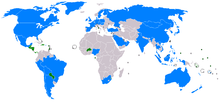
Before 1928, the foreign policy of Republican China was complicated by a lack of internal unity—competing centers of power all claimed legitimacy. This situation changed after the defeat of the Peiyang Government by the Kuomintang, which led to widespread diplomatic recognition of the Republic of China.
After the KMT's retreat to Taiwan, most countries, notably the countries in the Western Bloc, continued to maintain relations with the ROC. Due to diplomatic pressure, recognition gradually eroded and many countries switched recognition to the PRC in the 1970s. UN Resolution 2758 (25 October 1971) recognized the People's Republic of China as China's sole representative in the United Nations.
The PRC refuses to have diplomatic relations with any nation that recognizes the ROC, and requires all nations with which it has diplomatic relations to make a statement recognizing its claims to Taiwan. As a result, only 22 UN member states and the Holy See maintain official diplomatic relations with the Republic of China. In practice, most countries view the ROC as an independent state and as such maintain unofficial relations with it.
The ROC maintains unofficial relations with most countries via de facto embassies and consulates called Taipei Economic and Cultural Representative Offices (TECRO), with branch offices called "Taipei Economic and Cultural Offices" (TECO). Both TECRO and TECO are "unofficial commercial entities" of the ROC in charge of maintaining diplomatic relations, providing consular services (i.e. visa applications), and serving the national interests of the ROC in other countries.
The United States is one of the main allies of the ROC and, since the Taiwan Relations Act passed in 1979, the United States has sold arms and provided military training to the Republic of China Armed Forces. This situation continues to be an issue for the People's Republic of China which considers US involvement disruptive to the stability of the region. In January 2010, the Obama administration announced its intention to sell $6.4 billion worth of military hardware to Taiwan. As a consequence, the PRC threatened the US with economic sanctions and warned that their cooperation on international and regional issues could suffer.
The official position of the United States is that the PRC is expected to "use no force or threat[en] to use force against Taiwan" and the ROC is to "exercise prudence in managing all aspects of Cross-Strait relations." Both are to refrain from performing actions or espousing statements "that would unilaterally alter Taiwan's status."
Participation in international events and organizations
The ROC was a founding member of the United Nations and held the seat of China on the Security Council and other UN bodies until 1971, when it was expelled by Resolution 2758 and replaced in all UN organs with the PRC. Each year since 1992, the ROC has petitioned the UN for entry but its applications have not made it past committee.
Due to its limited international recognition, the Republic of China is a member of the Unrepresented Nations and Peoples Organization, represented by a government-funded organization, the Taiwan Foundation for Democracy (TFD) under the name "Taiwan".
Also due to its One China policy, the PRC only participates in international organizations where the ROC is not recognized as a sovereign country. Most member states, including the United States, do not wish to discuss the issue of the ROC's political status for fear of souring diplomatic ties with the PRC. However, both the US and Japan publicly support the ROC's bid for membership in the World Health Organization as an observer. However, though the ROC has applied for WHO membership every year since 1997 under various denominations, their efforts have consistently been blocked by PRC.
Due to PRC pressure, the ROC is forced to use the name " Chinese Taipei" in international events such as the Olympic Games where the PRC is also a party. The ROC is typically barred from using its national anthem and national flag in international events due to PRC pressure; ROC spectators attending events such as the Olympics are often barred from bringing ROC flags into venues. The ROC is able to participate as "China" in organizations that the PRC does not participate in, such as the World Organization of the Scout Movement.
Opinions within Taiwan
Within Taiwan, opinions are polarized between those supporting unification, represented by the Pan-Blue Coalition of parties, and those supporting independence, represented by the Pan-Green Coalition.
The KMT, the largest Pan-Blue party, supports the status quo for the indefinite future with a stated ultimate goal of unification. However, it does not support unification in the short term with the PRC as such a prospect would be unacceptable to most of its members and the public. Ma Ying-jeou, chairman of the KMT and the incumbent president of the ROC, has set out democracy, economic development to a level near that of Taiwan, and equitable wealth distribution as the conditions that the PRC must fulfill for reunification to occur.
The Democratic Progressive Party, the largest Pan-Green party, officially seeks independence, but in practice also supports the status quo because its members and the public would not accept the risk of provoking the PRC.
Former President Chen Shui-bian of the DPP stated during his years of administration that any decision should be decided through a public referendum of the people of the ROC. Both parties' current foreign policy positions support actively advocating ROC participation in international organizations, but while the KMT accepts the One-China principle, the DPP encourages the participation of Taiwan as a sovereign state.
On 2 September 2008, El Sol de México asked President Ma about his views on the subject of " two Chinas" and if there was a solution for the sovereignty issues between the two. The president replied that the relations are neither between two Chinas nor two states. It is a special relationship. Further, he stated that the sovereignty issues between the two cannot be resolved at present, but he quoted the " 1992 Consensus", currently accepted by both the Kuomintang and the Communist Party of China, as a temporary measure until a solution becomes available.
The relationship with the PRC and the related issues of Taiwanese independence and Chinese reunification continue to dominate politics.
Government
The government of the Republic of China was founded on the Constitution of the ROC and its Three Principles of the People, which states that the ROC "shall be a democratic republic of the people, to be governed by the people and for the people." The government is divided into five administrative branches (Yuan): the Executive Yuan (cabinet), the Legislative Yuan, the Judicial Yuan, the Control Yuan (audit agency), and the Examination Yuan (civil service examination agency). The Pan-Blue and Pan-Green coalitions are presently the dominant political blocs in the Republic of China.
The head of state and commander-in-chief of the armed forces is the president, who is elected by popular vote for a maximum of 2 four-year terms on the same ticket as the vice-president. The president has authority over the Yuan. The president appoints the members of the Executive Yuan as his cabinet, including a premier, who is officially the President of the Executive Yuan; members are responsible for policy and administration.
The main legislative body is the unicameral Legislative Yuan with 113 seats. Seventy-three are elected by popular vote from single-member constituencies; thirty-four are elected based on the proportion of nationwide votes received by participating political parties in a separate party list ballot; and six are elected from two three-member aboriginal constituencies. Members serve four-year terms. Originally the unicameral National Assembly, as a standing constitutional convention and electoral college, held some parliamentary functions, but the National Assembly was abolished in 2005 with the power of constitutional amendments handed over to the Legislative Yuan and all eligible voters of the Republic via referendums.
The premier is selected by the president without the need for approval from the legislature, but the legislature can pass laws without regard for the president, as neither he nor the Premier wields veto power. Thus, there is little incentive for the president and the legislature to negotiate on legislation if they are of opposing parties. After the election of the pan-Green's Chen Shui-bian as President in 2000, legislation repeatedly stalled because of deadlock with the Legislative Yuan, which was controlled by a pan-Blue majority. Historically, the ROC has been dominated by strongman single party politics. This legacy has resulted in executive powers currently being concentrated in the office of the president rather than the premier, even though the constitution does not explicitly state the extent of the president's executive power.
The Judicial Yuan is the highest judicial organ. It interprets the constitution and other laws and decrees, judges administrative suits, and disciplines public functionaries. The president and vice-president of the Judicial Yuan and additional thirteen justices form the Council of Grand Justices. They are nominated and appointed by the president, with the consent of the Legislative Yuan. The highest court, the Supreme Court, consists of a number of civil and criminal divisions, each of which is formed by a presiding judge and four associate judges, all appointed for life. In 1993, a separate constitutional court was established to resolve constitutional disputes, regulate the activities of political parties and accelerate the democratization process. There is no trial by jury but the right to a fair public trial is protected by law and respected in practice; many cases are presided over by multiple judges.
Capital punishment is still used in Taiwan, although efforts have been made by the government to reduce the number of executions. Nevertheless, according to a survey in 2006, about 80% of Taiwanese still wanted to keep the death penalty.
The Control Yuan is a watchdog agency that monitors (controls) the actions of the executive. It can be considered a standing commission for administrative inquiry and can be compared to the Court of Auditors of the European Union or the Government Accountability Office of the United States.
The Examination Yuan is in charge of validating the qualification of civil servants. It is based on the old imperial examination system used in dynastic China. It can be compared to the European Personnel Selection Office of the European Union or the Office of Personnel Management of the United States.
Politics

The constitution of the Republic of China was drafted before the fall of mainland China to the Communists. It was created by the KMT for the purpose of all of its claimed territory, including Taiwan, even though the Chinese Communist party boycotted the drafting of the constitution. The constitution went into effect on 25 December 1947.
The ROC remained under martial law from 1948 until 1987 and much of the constitution was not in effect. Political reforms beginning in the late 1970s and continuing through the early 1990s liberalized the country and transformed into a multiparty democracy. Since the lifting of martial law, the Republic of China has democratized and reformed, suspending constitutional components that were originally meant for the whole of China. This process of amendment continues. In 2000, the Democratic Progressive Party (DPP) won the presidency, ending KMT's continuous control of the government. In May 2005, a new National Assembly was elected to reduce the number of parliamentary seats and implement several constitutional reforms. These reforms have been passed; the National Assembly has essentially voted to abolish itself and transfer the power of constitutional reform to the popular ballot.
Major camps
The tension between the PRC and Taiwan colors most of the political life, and any government move towards "Taiwan independence" is met by threat of military attack from the PRC. The PRC's official policy is to reunify Taiwan and mainland China under the formula of " one country, two systems" and refuses to renounce the use of military force, especially should Taiwan seek a declaration of independence.
The political scene is generally divided into two major camps in terms of views on how Taiwan should relate to China or the PRC, referred to as Cross-Strait relations. It is the main political difference between two camps: the Pan-Blue Coalition, composed of the pro-unification Kuomintang, People First Party (PFP), and New Party, who believe that the ROC is the sole legitimate government of "China" (including Taiwan) and supports eventual Chinese reunification. The opposition Pan-Green Coalition is composed of the pro-independence DPP and Taiwan Solidarity Union (TSU). It regards Taiwan as an independent, sovereign state synonymous with the ROC, opposes the definition that Taiwan is part of "China", and seeks wide diplomatic recognition and an eventual declaration of formal Taiwan independence. The Pan-Green camp tends to favour emphasizing the Republic of China as being a distinct country from the People's Republic of China. Thus, in September 2007, the then ruling Democratic Progressive Party approved a resolution asserting separate identity from China and called for the enactment of a new constitution for a "normal country". It called also for general use of "Taiwan" as the country's name, without abolishing its formal name, the "Republic of China". Some members of the coalition, such as former President Chen Shui-bian, argue that it is unnecessary to proclaim independence because "Taiwan is already an independent, sovereign country" and the Republic of China is the same as Taiwan. Despite being a member of KMT prior to and during his presidency, Lee Teng-hui also held a similar view and was a supporter of the Taiwanization movement.
Pan-Blue members generally support the concept of the One-China policy, which states that there is only one China and that its only government is the ROC. They favour eventual re-unification of China. The more mainstream Pan-Blue position is to lift investment restrictions and pursue negotiations with the PRC to immediately open direct transportation links. Regarding independence, the mainstream Pan-Blue position is to maintain the status quo, while refusing immediate reunification. President Ma Ying-jeou stated that there will be no unification nor declaration of independence during his presidency. As of 2009, Pan-Blue members usually seek to improve relationships with mainland China, with a current focus on improving economic ties.
Current political issues
The dominant political issue in Taiwan is its relationship with the PRC. For almost 60 years, there were no direct transportation links, including direct flights, between Taiwan and mainland China. This was a problem for many Taiwanese businesses that had opened factories or branches in mainland China. The former DPP administration feared that such links would lead to tighter economic and political integration with mainland China, and in the 2006 Lunar New Year Speech, President Chen Shui-bian called for managed opening of links. Direct weekend charter flights between Taiwan and mainland China began in July 2008 under the current KMT government, and the first direct daily charter flights took off in December 2008.
Other major political issues include the passage of an arms procurement bill that the United States authorized in 2001. In 2008, however, the United States were reluctant to send over more arms to Taiwan out of fear that it would hinder the recent improvement of ties between the PRC and the ROC. Another major political issue is the establishment of a National Communications Commission to take over from the Government Information Office, whose advertising budget exercised great control over the media.
The politicians and their parties have themselves become major political issues. Corruption among some DPP administration officials has been exposed. In early 2006, President Chen Shui-bian was linked to possible corruption. The political effect on President Chen Shui-bian was great, causing a divide in the DPP leadership and supporters alike. It eventually led to the creation of a political camp led by ex-DPP leader Shih Ming-teh which believes the president should resign. The KMT assets continue to be another major issue, as it was once the richest political party in the world. Nearing the end of 2006, KMT's chairman Ma Ying-jeou was also hit by corruption controversies, although he has since then been cleared of any wrong-doings by the courts. After completing his second term as President, Chen Shui-bian was charged with corruption and money laundering. Following his conviction, he is serving a 17-year sentence in Taipei Prison.
The merger of the KMT and People First Party (PFP) was thought to be certain, but a string of defections from the PFP to the KMT have increased tensions within the Pan-Blue camp.
National identity
Roughly 84% of Taiwan's population descends from Han Chinese who migrated from mainland China between 1661 and 1895. Another significant fraction descends from Han Chinese who immigrated from mainland China in the 1940s and 1950s. The shared cultural origin combined with several hundred years of geographical separation, some hundred years of political separation and foreign influences, as well as hostility between the rival ROC and PRC have resulted in national identity being a contentious issue with political overtones. Since democratization and the lifting of martial law, a distinct Taiwanese identity (as opposed to Taiwanese identity as a subset of a Chinese identity) is often at the heart of political debates. Its acceptance makes the island distinct from mainland China, and therefore may be seen as a step towards forming a consensus for de jure Taiwan independence. The pan-green camp supports a distinct Taiwanese identity, while the pan-blue camp supports a Chinese identity only. The KMT has downplayed this stance in the recent years and now supports a Taiwanese identity as part of a Chinese identity.
According to a survey conducted in March 2009, 49% of the respondents consider themselves as Taiwanese only, and 44% of the respondents consider themselves as Taiwanese and Chinese. 3% consider themselves as only Chinese. Another survey, conducted in Taiwan in July 2009, showed that 82.8% of respondents consider that the ROC and the PRC are two separate countries developing each on its own. A survey conducted in December 2009 showed that 62% of the respondents consider themselves as Taiwanese only, and 22% of the respondents consider themselves as both Taiwanese and Chinese. 8% consider themselves as only Chinese. The survey also shows that among 18- to 29-year-old respondents, 75% consider themselves as Taiwanese only.
In a survey conducted over 2012 by the Election Study Centre at National Chengchi University, 54.3% of residents (excluding those in Kinmen and Matsu) aged 20 or above identified themselves exclusively as Taiwanese, and 38.5% identified themselves as both Taiwanese and Chinese. On the other hand, in a survey conducted in February 2013 by the Taiwan Competitiveness Forum and Apollo Survey Company (艾普羅民意調查公司) in which Taiwanese identity was implied, it was shown that 61.1% of residents aged aged 20 or above (including those in Kinmen and Matsu) considered themselves to be Chinese.
| Survey | Taiwanese | Chinese | Taiwanese and Chinese |
|---|---|---|---|
| Research, Development, and Evaluation Commission, Executive Yuan (April 2008) | 67.1% | 13.6% | 15.2% |
| Common Wealth Magazine (December 2009) | 62% | 8% | 22% |
| National Chengchi University (June 2012) | 53.6% | 3.1% | 39.6% |
| TVBS Poll Centre (October 2012) | 75% | 15% | (not an option for this question) |
| TVBS Poll Centre (October 2012) | 55% | 3% | 37% |
Military
The Republic of China Army takes its roots in the National Revolutionary Army, which was established by Sun Yat-sen in 1925 in Guangdong with a goal of reunifying China under the Kuomintang. When the People's Liberation Army won the Chinese Civil War, much of the National Revolutionary Army retreated to Taiwan along with the government. It was later reformed into the Republic of China Army. Units which surrendered and remained in mainland China were either disbanded or incorporated into the People's Liberation Army.
Today, the Republic of China maintains a large and technologically advanced military, mainly as defense against the constant threat of invasion by the PRC under the Anti-Secession Law of the People's Republic of China. From 1949 to the 1970s, the primary mission of the military was to "retake the mainland" through Project National Glory. As this mission has shifted to defense, the ROC military has begun to shift emphasis from the traditionally dominant Army to the air force and navy. Control of the armed forces has also passed into the hands of the civilian government. As the ROC military shares historical roots with the KMT, the older generation of high-ranking officers tends to have Pan-Blue sympathies. However, many have retired and there are many more non-mainlanders enlisting in the armed forces in the younger generations, so the political leanings of the military have moved closer to the public norm in Taiwan.
The ROC began a force reduction program to scale down its military from a level of 450,000 in 1997 to 380,000 in 2001. As of 2009, the armed forces of the ROC number approximately 300,000, with nominal reserves totaling 3.6 million as of 2005. Conscription remains universal for qualified males reaching age eighteen, but as a part of the reduction effort many are given the opportunity to fulfill their draft requirement through alternative service and are redirected to government agencies or defense related industries. Current plans call for a transition to a predominantly professional army over the next decade. Conscription periods are planned to decrease from 14 months to 12. In the last months of the Bush administration, Taipei took the decision to reverse the secular trend of declining defense spending, at a time when most Asian countries kept on reducing their military expenditures. It also decided to modernize both defensive and offensive capabilities. Taipei still keeps a large military apparatus relative to the island’s population: defense expenditures for 2008 were NTD 334 billion (approximately U.S. $10.5 billion), which accounted for 2.94% of GDP.
The armed forces' primary concern at this time is the possibility of an attack by the PRC, consisting of a naval blockade, airborne assault and/or missile bombardment. Four upgraded Kidd class destroyers were recently purchased from the United States, significantly upgrading Taiwan's air defense and submarine hunting abilities. The Ministry of National Defense planned to purchase diesel-powered submarines and Patriot anti-missile batteries from the United States, but its budget has been stalled repeatedly by the opposition- Pan-Blue Coalition controlled legislature. The defense package was stalled from 2001 to 2007 where it was finally passed through the legislature and the US responded on 3 October 2008, with a $6.5 billion arms package including PAC III Anti-Air defense systems, AH-64D Apache Attack helicopters and other arms and parts. A significant amount of military hardware has been bought from the United States, and, as of 2009, continues to be legally guaranteed by the Taiwan Relations Act. In the past, France and the Netherlands have also sold military weapons and hardware to the ROC, but they almost entirely stopped in the 1990s under pressure of the PRC.
The first line of defense against invasion by the PRC is the ROC's own armed forces. Current ROC military doctrine is to hold out against an invasion or blockade until the US military responds. There is, however, no guarantee in the Taiwan Relations Act or any other treaty that the United States will defend Taiwan, even in the event of invasion. The joint declaration on security between the US and Japan signed in 1996 may imply that Japan would be involved in any response. However, Japan has refused to stipulate whether the "area surrounding Japan" mentioned in the pact includes Taiwan, and the precise purpose of the pact is unclear. The Australia, New Zealand, United States Security Treaty (ANZUS Treaty) may mean that other US allies, such as Australia, could theoretically be involved. In practice, the risk of losing economic ties with China may prevent Australia from taking action. The United States, United Kingdom, Japan, South Korea, Australia, Canada, Chile, and Peru conduct maritime exercises in the Pacific Ocean every 2 years called RIMPAC. They are conducted to promote stability and to be able to respond in case of an armed conflict in the region – that includes an invasion of Taiwan by China.
Administrative divisions

(Matsu)
According to the 1947 constitution, written and promulgated whilst the ROC government still controlled mainland China, the territory of the ROC consisted of provinces, special municipalities, as well as Mongolia and Tibet. Accordingly, when the ROC retreated to Taiwan in 1949, its claimed territory consisted of 35 provinces, 12 special municipalities, 1 special administrative region, as well as Mongolia and Tibet. However, since its retreat, the ROC has controlled only Taiwan Province and some islands of Fujian Province. The ROC also controls the Pratas Islands (Dong-Sha) and Taiping Island in the Spratly Islands, which are part of the disputed South China Sea Islands. They were placed under Kaohsiung administration after the retreat to Taiwan.
Since 1949, the government has made some changes in the area under its control. Taipei became a special municipality in 1967 and Kaohsiung in 1979. The two provincial governments were "streamlined", with their functions transferred to the central government (Fujian in 1956 and Taiwan in 1998). In 2010, New Taipei, Taichung and Tainan were upgraded to special municipalities. This brought the top-level divisions of the ROC to their current state:
| Level | Division type | Total | ||||
|---|---|---|---|---|---|---|
| 1st | Special municipality (直轄市 zhíxiáshì) (5) |
Province (省 shěng) (2) (Streamlined) | 22 | |||
| 2nd | Provincial city (市 shì) (3) |
County (縣 xiàn) (14) | ||||
| 3rd | District (區 qū) (157) | County-controlled city (縣轄市 xiànxiáshì) (17) |
Urban Township (鎮 zhèn) (41) |
Rural Township (鄉 xiāng) (153) |
368 | |
| 4th | Village (里 lǐ) | Village (村 cūn) | 7,835 | |||
| 5th | Neighbourhood (鄰 lín) | 147,877 | ||||
According to Article 4 of the Local Government Act, laws pertaining to special municipalities also apply to counties with a population exceeding 2 million. This provision is currently applied only to Taoyuan County.
Economy and Industry
The quick industrialization and rapid growth of Taiwan during the latter half of the 20th century has been called the " Taiwan Miracle". Taiwan is one of the " Four Asian Tigers" alongside Hong Kong, South Korea and Singapore.
Japanese rule prior to and during World War II brought changes in the public and private sectors, most notably in the area of public works, which enabled rapid communications and facilitated transport throughout much of the island. The Japanese also improved public education and made it compulsory for all Taiwanese citizens.
By 1945, hyperinflation was in progress in mainland China and Taiwan as a result of the war with Japan. To isolate Taiwan from it, the Nationalist government created a new currency area for the island, and started a price stabilization program. These efforts helped significantly slow the inflation.
When the KMT government fled to Taiwan it brought millions of taels of gold and the foreign currency reserve of mainland China to the island, which, according to the KMT stabilized prices and reduced hyperinflation. Perhaps more importantly, as part of its retreat to Taiwan, the KMT brought the intellectual and business elites from Mainland China. The KMT government instituted many laws and land reforms that it had never effectively enacted on mainland China. The government also implemented a policy of import-substitution, attempting to produce imported goods domestically.
In 1950, with the outbreak of the Korean War, the US began an aid program which resulted in fully stabilized prices by 1952. Economic development was encouraged by American economic aid and programs such as the Joint Commission on Rural Reconstruction, which turned the agricultural sector into the basis for later growth. Under the combined stimulus of the land reform and the agricultural development programs, agricultural production increased at an average annual rate of 4 per cent from 1952 to 1959, which was greater than the population growth, 3.6 percent.
In 1962, Taiwan had a (nominal)per-capita gross national product (GNP) of $170, placing its economy on a par with those of Zaire and Congo. On a PPP basis, its GDP per capita in early 1960s is $1353(in 1990 constant prices). By 2011 per-capita GNP, adjusted for purchasing power parity (PPP), had risen to $37,000, contributing to a Human Development Index equivalent to that of other developed countries. Taiwan's HDI in 2007 is 0.943 (25th, very high), and stands at 0.868 in 2010 (18th, very high), according to the UN's new calculating method ("Inequality-adjusted HDI"). In 1974, Chiang Ching-kuo implemented the Ten Major Construction Projects, the beginning foundations that helped Taiwan transform into its current export driven economy.
Today Taiwan has a dynamic, capitalist, export-driven economy with gradually decreasing state involvement in investment and foreign trade. In keeping with this trend, some large government-owned banks and industrial firms are being privatized. Real growth in GDP has averaged about 8% during the past three decades. Exports have provided the primary impetus for industrialization. The trade surplus is substantial, and foreign reserves are the world's fifth largest. The Republic of China has its own currency, the New Taiwan dollar.
Since the beginning of the 1990s, the economic ties between Taiwan and Mainland China have been very prolific. As of 2008, more than US$150 billion have been invested in the PRC by Taiwanese companies, and about 10% of the Taiwanese labour force works in the PRC, often to run their own businesses. Although the economy of Taiwan benefits from this situation, some have expressed the view that the island has become increasingly dependent on the Mainland Chinese economy. A 2008 white paper by the Department of Industrial Technology states that "Taiwan should seek to maintain stable relation with China while continuing to protect national security, and avoiding excessive 'Sinicization' of Taiwanese economy." Others argue that close economic ties between Taiwan and Mainland China would make any military intervention by the PLA against Taiwan very costly, and therefore less probable.
Taiwan’s total trade in 2010 reached an all-time high of US$526.04 billion, according to Taiwan's Ministry of Finance. Both exports and imports for the year reached record levels, totaling US$274.64 billion and US$251.4 billion, respectively.
In 2001, agriculture constituted only 2% of GDP, down from 35% in 1952. Traditional labor-intensive industries are steadily being moved offshore and with more capital and technology-intensive industries replacing them. High-technology industrial parks have sprung up in every region in Taiwan. The ROC has become a major foreign investor in the PRC, Thailand, Indonesia, the Philippines, Malaysia, and Vietnam. It is estimated that some 50,000 Taiwanese businesses and 1,000,000 businesspeople and their dependents are established in the PRC.
Because of its conservative financial approach and its entrepreneurial strengths, Taiwan suffered little compared with many of its neighbors from the 1997 Asian Financial Crisis. Unlike its neighbors, South Korea and Japan, the Taiwanese economy is dominated by small and medium sized businesses, rather than the large business groups. The global economic downturn, however, combined with poor policy coordination by the new administration and increasing bad debts in the banking system, pushed Taiwan into recession in 2001, the first whole year of negative growth since 1947. Due to the relocation of many manufacturing and labor intensive industries to the PRC, unemployment also reached a level not seen since the 1970s oil crisis. This became a major issue in the 2004 presidential election. Growth averaged more than 4% in the 2002–2006 period and the unemployment rate fell below 4%.
The ROC often joins international organizations under a politically neutral name. The ROC is a member of governmental trade organizations such as the World Trade Organization under the name Separate Customs Territory of Taiwan, Penghu, Kinmen and Matsu ( Chinese Taipei) since 2002.
Transportation
The Ministry of Transportation and Communications of the Republic of China is the cabinet-level governing body for the transportation network in Taiwan. Highways in Taiwan can be classified into five levels: National highways, provincial highways, county routes, township routes, and special routes, with the first four being common. Taiwan has an extensive rail network, which is managed by the Taiwan Railway Administration with the exception of the high-speed rail line, which is run by Taiwan High Speed Rail Corporation. Taipei Metro and the Kaohsiung Mass Rapid Transit serve the Taipei metropolitan area and the city of Kaohsiung, respectively, and Taichung Metro is currently under construction. Major airports include Taiwan Taoyuan International Airport, Taipei Songshan Airport, Kaohsiung International Airport, and Taichung Airport. The four international seaports are the Port of Keelung, the Port of Kaohsiung, the Port of Taichung, and the Port of Hualien.
Education, Research, and Academia
The higher education system was established in Taiwan by Japan during the colonial period. However, after the Republic of China took over Taiwan from Japan in 1945, the system was promptly replaced by the same system as in mainland China which mixed with features of the Chinese and American educational systems.
The educational system includes six years of elementary school, three years of middle school, three years of high school, and four years of university. The system has been successful in that pupils in Taiwan boast some of the highest test scores in the world, especially in mathematics and science; However, it has also been criticized for placing excessive pressure on students and eschewing creativity in favour of rote memorization.
Many Taiwanese students attend cram schools, or bushiban, to improve skills and knowledge on problem solving against exams of subjects like mathematics, nature science, history and many others. Courses are available for most popular subjects. Lessons are organized in lectures, reviews, private tutorial sessions, and recitations.
As of 2003, the literacy rate in Taiwan is 96.1%.
Demographics
Taiwan's population was estimated in 2012 at 23,261,747, most of whom are on the island of Taiwan. The remainder live on Penghu (97,724), Kinmen (108,147) and the Matsu Islands (10,253).
Ethnic groups
About 98% of Taiwan's population is of Han Chinese ethnicity. Of these, 86% are descendants of early Han Chinese immigrants known as the "benshengren" (Chinese: 本省人; pinyin: Běnshěng rén; literally "home-province person") in Chinese. This group is often referred to "native Taiwanese" in English, but the term is also frequently used for the Taiwanese aborigines. The benshengren group contains two subgroups: the Hoklo people (70% of the total population), whose ancestors migrated from the coastal southern Fujian (Min-nan) region in the southeast of mainland China starting in the 17th century, and the Hakka (15% of the total population), whose ancestors originally migrated south to Guangdong, its surrounding areas and Taiwan.
About 12% of the population are known as waishengren (Chinese: 外省人; pinyin: Wàishěng rén; literally "out-of-province person"), composed of people who emigrated from mainland China after 1945.
The other 2.25% of the population are about 522,942 Taiwanese aborigines, divided into 14 major groups. The Ami, Atayal, Bunun, Kavalan, Paiwan, Puyuma, Rukai, Saisiyat, Sakizaya, Sediq, Thao, Truku and Tsou live mostly in the eastern half of the island, while the Yami inhabit Orchid Island.
Languages
Mandarin is the official national language and is spoken by the vast majority of the population of Taiwan. It has been the primary language of instruction in schools since the Japanese were forced out in the 1940s. As in Hong Kong and Macau, Traditional Chinese in used in Taiwan.
Most Waishengren speak primarily Mandarin. The 70% of the population belonging to the Hoklo ethnic group speak Taiwanese (a variant of the Min Nan speech of Fujian province) as their mother tongue, in addition to Mandarin, and many others have some degree of understanding. The Hakka ethnic group (15% of the population) use the Hakka language. Although Mandarin is the language of instruction in schools and dominates television and radio, non-Mandarin languages or dialects have undergone a revival in public life in Taiwan, particularly since restrictions on their use were lifted in the 1990s.
Taiwan's indigenous languages, the Formosan languages, do not belong to the Chinese or Sino-Tibetan language family, but rather to the Austronesian language family. Their use among Taiwan's aboriginal minority groups has been in decline as usage of Mandarin has risen. Of the 14 extant languages, five are considered moribund.
Religion
The Constitution of the Republic of China protects people's freedom of religion and the practices of belief. There are approximately 18,718,600 religious followers in Taiwan as of 2005 (81.3% of total population) and 14–18% are non-religious. According to the 2005 census, of the 26 religions recognized by the ROC government, the five largest are: Buddhism (8,086,000 or 35.1%), Taoism (7,600,000 or 33%), I-Kuan Tao (810,000 or 3.5%), Protestantism (605,000 or 2.6%), and Roman Catholicism (298,000 or 1.3%). But according to the CIA World Factbook and other latest sources from US State Department or the Religious Affairs Section of the MOI, over 93% of Taiwanese are adherents of a combination of the polytheistic ancient Chinese religion, Buddhism, Confucianism, and Taoism; 4.5% are adherents of Christianity, which includes Protestants, Catholics, and other, non-denominational, Christian groups; and less than 2.5% are adherents of other religions, such as Islam. Taiwanese aborigines comprise a notable subgroup among professing Christians: "...over 64 percent identify as Christian... Church buildings are the most obvious markers of Aboriginal villages, distinguishing them from Taiwanese or Hakka villages."
Confucianism is a philosophy that deals with secular moral ethics, and serves as the foundation of both Chinese and Taiwanese culture. The majority of Taiwanese people usually combine the secular moral teachings of Confucianism with whatever religions they are affiliated with.
As of 2009, there are 14,993 temples in Taiwan, approximately one place of worship per 1,500 residents. 9,202 of those temples were dedicated to Taoism. In 2008, Taiwan had 3,262 Churches, an increase of 145.
Largest cities
The figures below are the 2011 estimates for the twenty largest urban populations within administrative city limits; a different ranking exists when considering the total metropolitan area populations (in such rankings the Taipei-Keelung metro area is by far the largest agglomeration).
| Largest cities or towns of Taiwan source |
|||||||||
|---|---|---|---|---|---|---|---|---|---|
| Rank | City name | Division | Pop. | ||||||
 New Taipei |
1 | New Taipei | New Taipei City | 3,913,595 |  Taichung |
||||
| 2 | Kaohsiung | Kaohsiung City | 2,773,855 | ||||||
| 3 | Taichung | Taichung City | 2,662,770 | ||||||
| 4 | Taipei | Taipei City | 2,647,122 | ||||||
| 5 | Tainan | Tainan City | 1,876,706 | ||||||
| 6 | Hsinchu | Hsinchu City | 419,384 | ||||||
| 7 | Taoyuan | Taoyuan County | 409,796 | ||||||
| 8 | Keelung | Keelung City | 380,281 | ||||||
| 9 | Zhongli | Taoyuan County | 372,117 | ||||||
| 10 | Chiayi | Chiayi City | 271,594 | ||||||
Public health
Health care in Taiwan is managed by the Bureau of National Health Insurance (BNHI).
The current program was implemented in 1995, and is considered to be a form of social insurance. The government health insurance program maintains compulsory insurance for citizens who are employed, impoverished, unemployed, or victims of natural disasters with fees that correlate to the individual and/or family income; it also maintains protection for non-citizens working in Taiwan. A standardized method of calculation applies to all persons and can optionally be paid by an employer or by individual contributions.
BNHI insurance coverage requires co-payment at the time of service for most services unless it is a preventative health service, for low-income families, veterans, children under three years old, or in the case of catastrophic diseases. Low income households maintain 100% premium coverage by the BNHI and co-pays are reduced for disabled or certain elderly peoples.
According to a recently published survey, out of 3,360 patients surveyed at a randomly chosen hospital, 75.1% of the patients said they are "very satisfied" with the hospital service; 20.5% said they are "okay" with the service. Only 4.4% of the patients said they are either "not satisfied" or "very not satisfied" with the service or care provided.
Taiwan has its own Centre for Disease Control, and during the SARS outbreak in March 2003 there were 347 confirmed cases. During the outbreak the CDC and local governments set up monitored stations throughout public transportation, recreational sites and other public areas. With full containment in July 2003, there has not been a case of SARS since.
As of 2006, the BNHI Facility Contract Distribution facilities total 17,259, including:
| Number | Subject |
|---|---|
| 16,174 | outpatient-only facilities |
| 5,701 | dental clinics |
| 2,422 | Chinese medicine clinics |
| 1,085 | inpatient/outpatient facilities |
| 437 | local community hospitals |
| 35 | Chinese medicine hospitals |
| 123 | academic medical centers |
Basic coverage areas of the insurance include:
|
|
|
In 2004, the infant mortality rate was 5.3 with 15 physicians and 63 hospital beds per 10,000 people. The life expectancy for males was 73.5 years and 79.7 years for females according to the World Health Report.
Other health related programs in Taiwan are the Centers for Disease Control and the Department of Health.
Culture
The cultures of Taiwan are a hybrid blend of various sources, incorporating elements of traditional Chinese culture, attributable to the historical and ancestry origin of the majority of its current residents, Japanese culture, traditional Confucianist beliefs, and increasingly Western values.
After their move to Taiwan, the Kuomintang imposed an official interpretation of traditional Chinese culture over Taiwan. The government launched a program promoting Chinese calligraphy, traditional Chinese painting, folk art, and Chinese opera.
The status of Taiwanese culture is debated. It is disputed whether Taiwanese culture is a regional form of Chinese culture or a distinct culture. Reflecting the continuing controversy surrounding the political status of Taiwan, politics continues to play a role in the conception and development of a Taiwanese cultural identity, especially in the prior dominant frame of a Taiwanese and Chinese dualism. In recent years, the concept of Taiwanese multiculturalism has been proposed as a relatively apolitical alternative view, which has allowed for the inclusion of mainlanders and other minority groups into the continuing re-definition of Taiwanese culture as collectively held systems of meaning and customary patterns of thought and behaviour shared by the people of Taiwan. Identity politics, along with the over one hundred years of political separation from mainland China, has led to distinct traditions in many areas, including cuisine and music.
One of Taiwan's greatest attractions is the National Palace Museum, which houses more than 650,000 pieces of Chinese bronze, jade, calligraphy, painting and porcelain, and is considered one of the greatest collections of Chinese art and objects in the world. The KMT moved this collection from the Forbidden City in Beijing in 1933 and part of the collection was eventually transported to Taiwan during the Chinese Civil War. The collection, estimated to be one-tenth of China's cultural treasures, is so extensive that only 1% is on display at any time. The PRC had said that the collection was stolen and has called for its return, but the ROC has long defended its control of the collection as a necessary act to protect the pieces from destruction, especially during the Cultural Revolution. Relations regarding this treasure have warmed recently; Beijing Palace Museum Curator Zheng Xinmiao said that artifacts in both Chinese and Taiwanese museums are "China's cultural heritage jointly owned by people across the Taiwan Strait."
The classical music culture in Taiwan is highly developed and features artists such as violinist Cho-Liang Lin, pianist Ching-Yun Hu, and the Lincoln Centre Chamber Music Society Artist Director Wu Han. Karaoke, drawn from contemporary Japanese culture, is extremely popular in Taiwan, where it is known as KTV. KTV businesses operate in a hotel-like style, renting out small rooms and ballrooms varying on the number of guests in a group. Many KTV establishments partner with restaurants and buffets to form all-encompassing elaborate evening affairs for families, friends, or businessmen. Tour buses that travel around Taiwan have several TV's, equipped not for watching movies, but primarily for singing Karaoke. The entertainment counterpart of a KTV is an MTV, being found much less frequently out of the city. There, movies out on DVD can be selected and played in a private theatre room. However MTV, more so than KTV, has a growing reputation for being a place that young couples will go to be alone and intimate.
Taiwan has a high density of 24-hour convenience stores, which, in addition to the usual services, provide services on behalf of financial institutions or government agencies such as collection of parking fees, utility bills, traffic violation fines, and credit card payments. They also provide a service for mailing packages.
Taiwanese culture has also influenced other cultures. Bubble tea and milk tea are available in Singapore, Malaysia, Australia, Europe and North America. Taiwan television shows are popular in Singapore, Malaysia and other Asian countries. Taiwanese films have won various international awards at film festivals around the world. Ang Lee, a Taiwanese director, has directed critically acclaimed films such as: Crouching Tiger, Hidden Dragon; Eat Drink Man Woman; Sense and Sensibility; Brokeback Mountain; Life of Pi; and Lust, Caution. Other famous Taiwanese directors include Tsai Ming-Liang, Edward Yang and Hou Hsiao-hsien.
Literature, philosophy, and the arts
Cinema, television, music, and performing arts
Sports
Baseball is Taiwan's national sport and it is a popular spectator sport. Two of the most famous Taiwanese baseball pitchers are Chien-Ming Wang and Wei-Yin Chen, both are starting pitchers in Major League Baseball. Other notable players playing in the United States include Chin-hui Tsao who played for the Colorado Rockies (2003–2005) and the Los Angeles Dodgers (2007), Hong-Chih Kuo, Fu-Te Ni, and Chin-lung Hu. The Chinese Professional Baseball League in Taiwan was established in 1989, and eventually absorbed the competing Taiwan Major League in 2003. As of 2008, the CPBL has four teams with average attendance of approximately 3,000 per game.
Besides baseball, basketball is Taiwan's major sport. Taekwondo has also become a mature and successful sport in recent years. In the 2004 Olympics, Chen Shih-hsin and Chu Mu-yen won the first two gold medals in women's flyweight event and men's flyweight event, respectively. Subsequent taekwondo competitors such as Yang Shu-chun have strengthened Taiwan's taekwondo culture.
Taiwan participates in international sporting organizations and events under the name of " Chinese Taipei" due to its political status. In 2009, Taiwan hosted two international sporting events on the island. The World Games 2009 were held in Kaohsiung between 16 and 26 July 2009. Taipei hosted the 21st Summer Deaflympics in September of the same year. Furthermore, Taipei will host the Summer Universiade in 2017.
Taiwan is also a major Asian country for Korfball. In 2008, Taiwan hosted the World Youth Korfball Championship and took the silver medal. In 2009, Taiwan's korfball team won a bronze medal at the World Game.
Yani Tseng is the most famous Taiwanese professional golfer currently playing on the U.S.-based LPGA Tour. She is the youngest player ever, male or female, to win five major championships and had been ranked number 1 in the Women's World Golf Rankings for 109 consecutive weeks from 2011 to 2013.
Foods, cuisine, and shopping
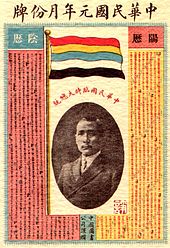
Calendar
Taiwan uses two official calendars: the Gregorian calendar, and the Minguo calendar. The latter numbers years starting from 1911, the year of the founding of the Republic of China. For example, 2007 is the "96th year of the Republic", while its months and days are numbered according to the Gregorian calendar.
Usually, year numbering may use the Gregorian system as well as the ROC era system. For example, 3 May 2004, may be written 2004-05-03 or 93–05–03. The use of two different calendar systems in Taiwan may be confusing, in particular for foreigners. For instance, products for export marked using the Minguo calendar can be misunderstood as having an expiration date 11 years earlier than intended.
Taiwan also uses the lunar calendar for traditional festivals such as the Chinese New Year, the Lantern Festival, and the Dragon Boat Festival.
Works cited
- Fenby, Jonathan (2009). The Penguin History of Modern China: The Fall and Rise of a Great Power, 1850–2009. Penguin Books. ISBN 0-7139-9832-6.
- "2008 White Paper on Taiwan Industrial Technology". Department of Industrial Technology. 2008. Retrieved 27 November 2009.
- Fung, Edmund S. K. (2000). In search of Chinese democracy: civil opposition in Nationalist China, 1929–1949. Cambridge modern China series. Cambridge University Press. ISBN 978-0-521-77124-5.
- Makinen, Gail E.; Woodward, G. Thomas (1989). "The Taiwanese hyperinflation and stabilization of 1945–1952". Journal of Money, Credit and Banking 21 (1): 90–105. doi: 10.2307/1992580. JSTOR 1992580.
- Makeham, John; Hsiau, A-chin, eds. (2005). Cultural, Ethnic, and Political Nationalism in Contemporary Taiwan: Bentuhua. New York: Palgrave Macmillan. ISBN 978-1-4039-7020-6.


